Effect of Achillea wilhelmsii extract on expression of the human telomerase reverse transcriptase mRNA in the PC3 prostate cancer cell line
- Authors:
- Published online on: July 31, 2017 https://doi.org/10.3892/br.2017.956
- Pages: 251-256
Abstract
Introduction
Cancer is an international public health problem, has been considered as a hyper-proliferative disorder. Cancer contains of irreversible cell change, dysregulation of apoptosis, proliferation, invasion, angiogenesis and metastasis (1). More than 7 million deaths per year have been reported worldwide and it is predicted that the new cancer cases will reach 15 million every year by 2020. Prostate cancer (PCa) as the most commonly diagnosed urologic malignancy is the second most common cause of cancer death in men in developed countries (2). Androgen ablation is the most common and successful treatment for progressive PCa. However, presence of androgen-independent cells increase problems with PCa treatment (3). Hence, studies have attempted to replace the new targets for treatment of PCa including telomerase activity (4,5).
Telomerase is one of the most important targets of therapeutic intervention in various cancers (6). Telomeres are conserved, repetitive and large non-coding sequences located at the ends of eukaryotic chromosomes these sequences responsible for the protection of the genomic DNA integrity (7). During each round of cell division, DNA polymerase is not able to replicate the 5′ ends of chromosomes in normal somatic cells; consequently, the telomeres are progressively shortened. When the telomeres reach a critically short length, cells leave the cell cycle and DNA damage responses such as apoptosis and replicative senescence are initiated. Hence, a limited number of passages could be seen in normal somatic cells due to their telomere length (7,8).
In most tumor cells, telomerase is responsible for telomere maintenance. Telomerase is a RNA dependent DNA polymerase, synthesize TTAGGG tandem repeats to the 3′ end of the telomere on the lagging strand and confers cellular immortality. In this mechanism, telomerase is preventing telomere shortening and permitting continued proliferation (9). Telomerase contains two main subunits: The catalytic subunit called human telomerase reverse transcriptase (hTERT), which synthesizes the addition of TTAGGG tandem repeats to the 3′ end; and the telomerase RNA template subunit, the second subunit is an RNA template complementary to the 3′ end which used as primer for telomere synthesize (10).
Although continuing improvement in treatment of cancer is observed, more patients suffer from cancer treatment-related symptoms including fatigue, paresthesias and dysesthesias, chronic pain, anorexia, insomnia, limbs edema and constipation (11,12).
In traditional medicine, natural and herbal products have been considered as a main way for treatment of different diseases including infections and malignant diseases for a long time (13). In addition, several studies indicated that various herbal plants might have the anti-cancer effect by cell differentiation induction, inhibition of telomerase activity, induction of apoptosis in cancer cells and improving the immune system (13–15). Although it is believed that natural and herbal medicine have no side effects and lower dependency, different herbs could be toxic mainly in higher doses and long usage (16).
The Achillea genus (Asteraceae) with >130 species has been spread throughout the world, including Asia and Europe (17). In Iran, nineteen species of this genus have been recognized and approved for their essential oil (18). Achillea genus is widely used in traditional medicine (17,18). A previous study demonstrated that the Achillea species extracts exhibit antimicrobial, antioxidant and cytotoxic activities (19). Achillea wilhelmsii (AW) is a member of the Achillea genus, which is widely found in different regions of Iran. The effects of AW have been the topic of several studies, these effects may be attributed to high flavonoids and sesquiterpene lactones content (20,21). Evidences have reported that the extract and oil of Achillea species present cytotoxic effects against several cancer cell lines (19,22) and a recent study revealed cytotoxic activities of the hydroalcoholic extract of AW. on Breast cancer cell lines (22).
Although several research papers have evaluated the effects of AW extract on some cancers (19,22), there is no published report on the effects of AW extract in PCa cell lines. Therefore, in the current study, the effect of AW extract on apoptosis and expression of mRNA-hTERT gene was investigated in the PCa PC3 cell line.
Materials and methods
Plant material
AW C. Koch was collected from the Taftan area in Sistan and Baluchistan Province, Iran in spring 2015. The specimen was identified by one of the members of Research Institute of the University of Sistan and Baluchistan (Dr Ali Shahraki). The stem and leaf of AW were air dried in dark room and then powdered. Then, a solution (70% alcohol) of the AW was extracted using a Soxhlet extractor.
Chemicals and regents
RPMI-1640, fetal bovine serum (FBS), phosphate-buffered saline (PBS), streptomycin and Penicillin, trypsin, EDTA, trypan blue, were obtained from Gibco; Thermo Fisher Scientific, Inc. (Waltham, MA, USA). MTT and dimethyl sulfoxide (DMSO) were purchased from Sigma-Aldrich; Merck KGaA (Darmstadt, Germany). An Annexin V/fluorescein isothiocyanate (FITC) apoptosis detection kit was purchased from BioVision, Inc. (San Francisco, CA, USA) and a hTERT colorimetric assay kit was procured from ZellBio GmbH (Ulm, Germany). All the other materials were of analytical grade and purchased locally.
Cell culture
PCa cell line PC3 was purchased from National Cell Bank of Iran (Pasteur Institute, Tehran, Iran). PC3 cells were cultured at a density between 0.5–1.0×106 cells/ml in RPMI-1640 medium, containing 10% heat-inactivated FBS, 100 U/ml penicillin, 100 µg/ml streptomycin in a CO2 incubator at 37°C in a moistened atmosphere of 5% CO2 and 95% air. When the PC3 cells reached logarithmic growth phase, the cells were sub-cultured and the experiments were performed immediately on the sub-cultured cells.
Cell treatments
For treatment, the powder of AW was dissolved in DMSO (HPLC grade) and kept frozen in the −20°C. The cells were seeded into sterile 96-well microplates at a density of 5×103 cells/well. The cells were incubated overnight (37°C, 5% CO2 and 95% air) for adhering the cells to button plates. Then the medium was removed, and different concentrations of extract were added.
MTT assay
The anti-proliferative activity of the AW was assessed using MTT assay as previously described. Cells were plated onto 96-well plates at 5×103 cells/well in 0.1 ml RPMI medium. Following 24 h of incubation, cells were treated with 0, 12.5, 25, 50, 100, 150 and 200 µg/ml AW extract for 24, 48 and 72 h. Then, 20 µl MTT were added to each well and incubated at 37°C for 4 h. Then the culture medium was discarded and finally, 200 µl DMSO was mixed with the cells for solubilization of Formazan crystals and incubated in a dark place for 2 h at room temperature.
Absorbance of cells in each well was measured at 570 nm by a microplate reader (Anthos 2020; Biochrom Ltd., Cambridge, UK). All experiments were conducted independently three times. The OD treated/OD control was considered as the cell viability percentage.
Cell apoptosis
Cell apoptosis was measured using Annexin V-Cy5 and propidium iodide (PI) staining and analyzed by flow cytometry (18). 1×105 cells per well were seeded in six well plates and incubated overnight, and then treated with 0, 50, 100, 150 and 200 µg/ml of HAWE for 48 h.
All cells were washed two times with cold PBS. Subsequently, the washed PC3 cells were stained in a 250 µl 1X binding buffer, 2.5 µl Annexin V/FITC, and 2.5 µl PI. Then, the stained cells were inculcated in a dark place for 15 min at room temperature.
Cell cycle analysis was conducted using a flow cytometer (Partec CyFlow Space, Sysmex Partec GmbH, Görlitz, Germany) with FloMax version 2.7 software. The distribution of cells in different cell cycle phases including living, early apoptosis, late apoptosis and necrosis phases was assessed.
mRNA expression analysis by reverse transcription-quantitative polymerase chain reaction (RT-qPCR)
PC3 cells (2×105 cells/well) were cultured in a six-well plates and incubated at 37°C in a moistened air of 5% CO2 overnight. Cells were then treated for 2, 4, 8, 12, 24, 48 and 72 h with a 150 µg/ml concentration of AW extract. Total RNA was isolated using RNx (Invitrogen; Thermo Fisher Scientific, Inc.) according to the manufacturer's protocol (17). Isolated RNA was treated with RNase-free DNase I (Promega Corporation, Madison, WI, USA), and the concentration and purity of the isolated RNA were determined.
First strand cDNA was synthesized from the cells' extracted RNA by using the RevertAid First Strand cDNA Synthesis kit (cat. no. K1621; Thermo Fisher Scientific, Inc.) based on the manufacturer's protocol.
The expression levels of hTERT were detected using the SYBR ExScript RT-qPCR kit (Takara Bio, Inc., Otsu, Japan). PCR amplification was performed with Master PCR kit (CinnaGen, Tehran, Iran). PCR amplification for hTERT and β-actin mRNA consisted of 35 cycles (95°C for 45 sec, 56°C for 50 sec and 72°C for 50 sec). To identify hTERT mRNA the following primers were used: forward primer, 5′-CGGAAGAGTGTCTGGAGCAA-3′, reverse primer, 5′-GGATGAAGCGGAGTCTGGA-3′ (23). To identify β-actin mRNA following primers were used: forward primer: 5′-AGAAAATCTGGCACCACACC-3′, reverse primer: 5′-GGAAGGAAGGCTGGAAGAGT-3′.
hTERT concentration assay
The hTERT concentration was measured by ELISA assay kit (cat. no. ZB-10934B-H9648; ZellBio GmbH) according to manufacturer's protocol.
Statistical analysis
The SPSS software package (version 23.0; IBM SPSS, Armonk, NY, USA) was used for statistical analysis. Each experiment was performed at least three times for all data. All the data were represented as mean ± standard deviation, and the nonparametric analysis of variance test, with post hoc Tukey test, was used for statistical analysis between the groups. P<0.05 was considered to indicate a statistically significant difference.
Results
Cytotoxicity activity
Significant inhibitory effect of AW extract has been seen in 150 µg/ml concentration (IC50) on PC3 cell line after treatment for 48 h. In addition, the inhibitory effect of AW extract was in dose- and time-dependent manner (Fig. 1). The half maximal inhibitory concentration (IC50) was defined as the AW concentration value which inhibits the viability of PC3 cells in culture by 50% compared to the untreated cells (control).
Cell apoptosis
The percentage of cells in Live (Annexin V-/PI-), early apoptosis (Annexin V+/PI-), late apoptosis and dead (Annexin V+/PI+) phases are presented in Fig. 2. Following a 48 h treatment of the PC3 cells with AW extract, a significant increase in early and late apoptotic cells and a decrease in live cells was observed in a dose-dependent manner. Moreover, the early apoptotic cells were significantly higher than late apoptotic cells (Fig. 3).
hTERT expression
The hTERT mRNA expression levels were not different compared to control group after 2, 4, 8 and 12 h. However, the hTERT mRNA expression levels were significantly decreased after 24, 48 and 72 h treatment with 150 μg/ml concentration of AW extract compared to control. There were no significant differences regarding to hTERT mRNA expression levels between 24, 48 and 72 h of treatment (Fig. 4).
hTERT level
The hTERT levels have been presented in Fig. 5. Following treatment for 2, 4, 8 or 12 h, the hTERT levels were not different compared to control. The hTERT level was significantly decreased following 24 h treatment with marginal P-value (P=0.043). However, the hTERT levels were significantly declined in 48 and 72 h following treatment (P<0.001). There were no significant differences between 24, 48 and 72 h treatments (Fig. 5).
Discussion
PCa is the second reason of cancer-related deaths after lung cancer in men. Androgen ablation is the prominent and the most successful treatment of progressive PCa, however, after treatment the tumor cells become insensitive to androgen hormone. Therefore, new targets required for therapeutic intervention of androgen-independent PCa. Therefore, telomerase could be a suitable and main target for therapeutic intervention in this cancer (2,3). Most normal cells typically lack telomerase activity, but this enzyme expressed in >85% of all human cancer cells (23,24). Higher telomerase levels are identified in the most of PCas, but, not in normal or benign prostatic hyperplasia tissues (6). Existing data suggest that hTERT expression and telomerase activity are positively regulated by androgenic stimuli in androgen-dependent PC (ADPC) cells. Evidence demonstrated that AR regulates the EGR1 expression that in turn controls positively the hTERT expression in CRPC cells. Thus, AR exerts an inhibitory effect on hTERT expression and telomerase activity by modulating EGR1 levels in CRPC cells (25).
Expression and reactivation of telomerase has also been described as an important feature of PCa. Telomerase activity was found in up to 100% of analyzed PCa cases (26). Interestingly, high expression of telomerase components does not always result in mandatory telomerase activity (27). In addition, hTERT expression was significantly associated with the aggressive behavior of prostate tumors (28). Previously, promising in vitro data were published identifying telomerase as a main target of an anti-androgen therapy in PCa, and the effectiveness of boron derivatives as a telomerase inhibitors (29,30). These data suggested telomerase inhibition as a reasonable therapeutic approach for the treatment of PCa, though, the molecular and cellular pathways involved in telomerase reactivation in PCa are still not clear. Expression of TERT and the telomerase activity were regulated by androgen receptor signaling, whereas exogenous expression of AR surprisingly led to inhibition of TERT transcription in PCa cells (31,32).
According to this fact that some PCa cells become insensitive to AR treatment, in the current study, the authors investigated the effects of the herbal extract of AW on apoptosis and hTERT expression in an insensitive prostatic cancer cell line to AR treatment.
PC3 is a PCa cell line that is established from bone metastasis of grade IV of PCa. This cell line has potential metastatic activity and do not respond to androgens, glucocorticoids or fibroblast growth factors. This cell line is useful in investigating the therapeutic interventions in progressive prostatic cancer cells (33).
In the current study, the apoptotic effect of AW extract on the PC3 cell line was assessed and the effects of this plant on hTERT expression and concentration were determined.
The findings demonstrated the appropriate inhibitory effect of AW extract in 150 µg/ml concentration (IC50) on PC3 cell line following AW treatment for 48 h. Proliferation of the PC3 cells was significantly inhibited in a dose- and time-dependent manner. A significant increase in early and late apoptotic cells and a decrease in live cells in a dose-dependent manner was observed following treatment with AW extract for 48 h. Moreover, the early apoptotic cells were significantly higher than late apoptotic cells. The relative mRNA expression was decreased following 24 h treatment of AW extract compared to control, however it was not different between 2, 4, 8 and 12 h treatments or 24, 48 and 72 h treatments. In addition, the hTERT concentration was significantly decreased after 24 h treatment of AW extract with marginal P-value. There was no significant difference regarding to hTERT concentration between 2, 4, 8 and 12 h treatments or 24, 48 and 72 h treatments.
The apoptotic effects of AW species extracts have been investigated in various cancer cell lines. The flavonoid casticin derived from Achilleamillefolium, demonstrated an important effect in cancer therapy (34). The anticancer effects of the various species of Achillea have been reported in different cancer cell lines (35,36). The cytotoxic and pro- apoptotic effects of methanol and water extracts of Achillea teretifolia on DU145 and PC3 PCa cell lines were considered in a recent study (37).
However, studies on the apoptotic effects of AW extract are rare. In a study, the cytotoxic effects of essential oils extracted from leaves of AW C. Koch have been described in several cancer cell lines including PC3 (38). In a similar study, the anti-proliferative and apoptosis-inducing potential of hydroalcoholic AW C. Koch extract were investigated on MCF-7 and MDA-Mb-468 human breast carcinoma cell lines. Consistent to results of current study, the apoptosis-inducing potential of the hydroalcoholic AW extract was indicated, however they observed this effect with lower concentration of AW extract compared with the present authors' results on the PC3 cell line (25 vs. 150 µg/ml) (22).
In addition, there was no published report on the effects of not only AW C. Koch extract but also other species of Achillea on the hTERT mRNA expression or concentration in different cancer cell lines. However, several studies investigated the effect of other herbal extracts on telomerase expression and concentration in PCa cell lines. Fruit extract of Gleditsia sinensis exhibited anti-cancer and telomerase inhibition effects on ESCC (esophageal squamous cell carcinoma) cell line (39). In human lung carcinoma cell line A549, aqueous extract of the Platycodon grandiflorum root represents the apoptotic events with the reduced telomerase activity and downregulation of Bcl2 expression (40).
The effect of hydroalcoholic extract of Melissa officinalis on human lung, breast and PCa cell lines demonstrated the potent anti-proliferative activity of this extract via parallel downregulation of VEGF-A and hTERT (41).
The investigation on the pristimerin effects on PCa LNCaP and PC3 cell lines exhibited that this quinonemethide triterpenoid inhibited the hTERT mRNA expression and suppressed the native and phosphorylated hTERT protein and hTERT telomerase activity (42).
In another study, the effects of PC-SPES, herbal formulation for PCa, on LNCaP, PC-3 and DU 145 PCa cell lines have been studied and the finding presented unchanged levels of telomerase in each of the lines (43).
In conclusion, the current findings demonstrated that the herbal extract of AW has an apoptotic effect on PC3 PCa cell line. In addition, the herbal extract of AW can inhibit hTERT mRNA expression. Further studies with each component of AW are required in various cancer cell lines to identify the active substance of this plant on telomerase expression and activity.
Acknowledgements
This study was extracted from the MS thesis (registered no. 7534) at Zahedan University of Medical Sciences (Zahedan, Iran). The authors would like to thank the Deputy of Research Affairs at the University for funding the current project.
References
|
The Lancet: Moving cancer up the global health agenda. Lancet. 375:20512010. View Article : Google Scholar : PubMed/NCBI | |
|
Siegel RL, Miller KD and Jemal A: Cancer statistics, 2015. CA Cancer J Clin. 65:5–29. 2015. View Article : Google Scholar : PubMed/NCBI | |
|
Rove KO and Crawford ED: Traditional androgen ablation approaches to advanced prostate cancer: New insights. Can J Urol. 21:14–21. 2014.PubMed/NCBI | |
|
Yu EM, Jain M and Aragon-Ching JB: Angiogenesis inhibitors in prostate cancer therapy. Discov Med. 10:521–530. 2010.PubMed/NCBI | |
|
Garrison JB and Kyprianou N: Novel targeting of apoptosis pathways for prostate cancer therapy. Curr Cancer Drug Targets. 4:85–95. 2004. View Article : Google Scholar : PubMed/NCBI | |
|
Biroccio A and Leonetti C: Telomerase as a new target for the treatment of hormone-refractory prostate cancer. Endocr Relat Cancer. 11:407–421. 2004. View Article : Google Scholar : PubMed/NCBI | |
|
Wright WE, Tesmer VM, Huffman KE, Levene SD and Shay JW: Normal human chromosomes have long G-rich telomeric overhangs at one end. Genes Dev. 11:2801–2809. 1997. View Article : Google Scholar : PubMed/NCBI | |
|
McElligott R and Wellinger RJ: The terminal DNA structure of mammalian chromosomes. EMBO J. 16:3705–3714. 1997. View Article : Google Scholar : PubMed/NCBI | |
|
de Lange T: Protection of mammalian telomeres. Oncogene. 21:532–540. 2002. View Article : Google Scholar : PubMed/NCBI | |
|
Venteicher AS, Abreu EB, Meng Z, McCann KE, Terns RM, Veenstra TD, Terns MP and Artandi SE: A human telomerase holoenzyme protein required for Cajal body localization and telomere synthesis. Science. 323:644–648. 2009. View Article : Google Scholar : PubMed/NCBI | |
|
Pachman DR, Barton DL, Swetz KM and Loprinzi CL: Troublesome symptoms in cancer survivors: Fatigue, insomnia, neuropathy, and pain. J Clin Oncol. 30:3687–3696. 2012. View Article : Google Scholar : PubMed/NCBI | |
|
Stark L, Tofthagen C, Visovsky C and McMillan SC: The Symptom Experience of Patients with Cancer. J Hosp Palliat Nurs. 14:61–70. 2012. View Article : Google Scholar : PubMed/NCBI | |
|
Tavakoli J, Miar S, Zadehzare M Majid and Akbari H: Evaluation of effectiveness of herbal medication in cancer care: A review study. Iran J Cancer Prev. 5:144–156. 2012.PubMed/NCBI | |
|
Baum M, Ernst E, Lejeune S and Horneber M: Role of complementary and alternative medicine in the care of patients with breast cancer: Report of the European Society of Mastology (EUSOMA) Workshop, Florence, Italy, December 2004. Eur J Cancer. 42:1702–1710. 2006. View Article : Google Scholar : PubMed/NCBI | |
|
Lian Z, Niwa K, Gao J, Tagami K, Mori H and Tamaya T: Association of cellular apoptosis with anti-tumor effects of the Chinese herbal complex in endocrine-resistant cancer cell line. Cancer Detect Prev. 27:147–154. 2003. View Article : Google Scholar : PubMed/NCBI | |
|
Fong HH: Integration of herbal medicine into modern medical practices: Issues and prospects. Integr Cancer Ther. 1:287–293; discussion 293. 2002. View Article : Google Scholar : PubMed/NCBI | |
|
Saeidnia S, Gohari A, Mokhber-Dezfuli N and Kiuchi F: A review on phytochemistry and medicinal properties of the genus Achillea. Daru. 19:173–186. 2011.PubMed/NCBI | |
|
Zargari A: Medicinal Plants. 2. 6th edition. Tehran University Publication; Tehran: 1996 | |
|
Zengin G, Aktumsek A, Ceylan R, Uysal S, Mocan A, Guler GO, Mahomoodally MF, Glamočlija J, Ćirić A and Soković M: Shedding light on the biological and chemical fingerprints of three Achillea species (A. biebersteinii, A. millefolium and A. teretifolia). Food Funct. 8:1152–1165. 2017. View Article : Google Scholar : PubMed/NCBI | |
|
Khazneh E, Hribova P, Hosek J, Pavel Suchý, Peter Kollár, Gabriela Pražanová, Jan Muselík, Zuzana Hanaková and Jiří Václavík: The chemical composition of Achillea wilhelmsii C. Koch and its desirable effects on hyperglycemia, inflammatory mediators and hypercholesterolemia as risk factors for cardiometabolic disease. Molecules. 21:4042016. View Article : Google Scholar : PubMed/NCBI | |
|
Niazmand S, Harandizadeh F, Mahmoudabady M, Hosseini M, Hasanzadeh M and Fereidouni E: Mechanism of vasorelaxation induced by Achillea wilhelmsii in rat isolated thoracic aorta. Adv Biomed Res. 3:912014. View Article : Google Scholar : PubMed/NCBI | |
|
Galavi HR, Saravani R, Shahraki A and Ashtiani M: Anti-proliferative and apoptosis inducing potential of hydroalcoholic Achillea wilhelmsii C. Koch extract on human breast adenocarcinoma cell lines MCF-7 and MDA-Mb-468. Pak J Pharm Sci. 29:(Suppl 6). 2397–2403. 2016. | |
|
Krams M, Hero B, Berthold F, Parwaresch R, Harms D and Rudolph P: Full-length telomerase reverse transcriptase messenger RNA is an independent prognostic factor in neuroblastoma. Am J Pathol. 162:1019–1026. 2003. View Article : Google Scholar | |
|
Broccoli D, Young JW and de Lange T: Telomerase activity in normal and malignant hematopoietic cells. Proc Natl Acad Sci USA. 92:9082–9086. 1995. View Article : Google Scholar : PubMed/NCBI | |
|
Jacob S, Nayak S, Kakar R, Chaudhari UK, Joshi D, Vundinti BR, Fernandes G, Barai RS, Kholkute SD and Sachdeva G: A triad of telomerase, androgen receptor and early growth response 1 in prostate cancer cells. Cancer Biol Ther. 17:439–448. 2016. View Article : Google Scholar : PubMed/NCBI | |
|
Meeker AK: Telomeres and telomerase in prostatic intraepithelial neoplasia and prostate cancer biology. Urol Oncol. 24:122–130. 2006. View Article : Google Scholar : PubMed/NCBI | |
|
Kamradt J, Drosse C, Kalkbrenner S, Rohde V, Lensch R, Lehmann J, Fixemer T, Bonkhoff H, Stoeckle M and Wullich B: Telomerase activity and telomerase subunit gene expression levels are not related in prostate cancer: A real-time quantification and in situ hybridization study. Lab Invest. 83:623–633. 2003. View Article : Google Scholar : PubMed/NCBI | |
|
de Kok JB, Verhaegh GW, Roelofs RW, Hessels D, Kiemeney LA, Aalders TW, Swinkels DW and Schalken JA: DD3(PCA3), a very sensitive and specific marker to detect prostate tumors. Cancer Res. 62:2695–2698. 2002.PubMed/NCBI | |
|
Korkmaz M, Avcı CB, Gunduz C, Aygunes D and Erbaykent-Tepedelen B: Disodium pentaborate decahydrate (DPD) induced apoptosis by decreasing hTERT enzyme activity and disrupting F-actin organization of prostate cancer cells. Tumour Biol. 35:1531–1538. 2014. View Article : Google Scholar : PubMed/NCBI | |
|
Liu S, Qi Y, Ge Y, Duplessis T, Rowan BG, Ip C, Cheng H, Rennie PS, Horikawa I, Lustig AJ, et al: Telomerase as an important target of androgen signaling blockade for prostate cancer treatment. Mol Cancer Ther. 9:2016–2025. 2010. View Article : Google Scholar : PubMed/NCBI | |
|
Guo C, Armbruster BN, Price DT and Counter CM: In vivo regulation of hTERT expression and telomerase activity by androgen. J Urol. 170:615–618. 2003. View Article : Google Scholar : PubMed/NCBI | |
|
Moehren U, Papaioannou M, Reeb CA, Grasselli A, Nanni S, Asim M, Roell D, Prade I, Farsetti A and Baniahmad A: Wild-type but not mutant androgen receptor inhibits expression of the hTERT telomerase subunit: A novel role of AR mutation for prostate cancer development. FASEB J. 22:1258–1267. 2008. View Article : Google Scholar : PubMed/NCBI | |
|
Kaighn ME, Narayan KS, Ohnuki Y, Lechner JF and Jones LW: Establishment and characterization of a human prostatic carcinoma cell line (PC-3). Invest Urol. 17:16–23. 1979.PubMed/NCBI | |
|
Haïdara K, Zamir L, Shi QW and Batist G: The flavonoid Casticin has multiple mechanisms of tumor cytotoxicity action. Cancer Lett. 242:180–190. 2006. View Article : Google Scholar : PubMed/NCBI | |
|
Grossini E, Marotta P, Farruggio S, Sigaudo L, Qoqaiche F, Raina G, de Giuli V, Mary D, Vacca G and Pollastro F: Effects of artemetin on nitric oxide release and protection against peroxidative injuries in porcine coronary artery endothelial cells. Phytother Res. May 29–2015.(Epub ahead of print). View Article : Google Scholar : PubMed/NCBI | |
|
Baharara J, Namvar F, Ramezani T, Mousavi M and Mohamad R: Silver nanoparticles biosynthesized using Achillea biebersteinii flower extract: Apoptosis induction in MCF-7 cells via caspase activation and regulation of Bax and Bcl-2 gene expression. Molecules. 20:2693–2706. 2015. View Article : Google Scholar : PubMed/NCBI | |
|
Bali EB, Açık L, Elçi P, Sarper M, Avcu F and Vural M: In vitro anti-oxidant, cytotoxic and pro-apoptotic effects of Achillea teretifolia Willd extracts on human prostate cancer cell lines. Pharmacogn Mag. 11:(Suppl 2). S308–S315. 2015. View Article : Google Scholar : PubMed/NCBI | |
|
Ahmadi-Jouibaria T, Nikbakht MR, Mansouri K and Majnooni MB: Cytotoxic effects of the essential oil from Achillea wilhelmsii C. Koch. J Rep Pharm Sci. 2:98–102. 2013. | |
|
Tang WK, Chui CH, Fatima S, Kok SH, Pak KC, Ou TM, Hui KS, Wong MM, Wong J, Law S, et al: Inhibitory effects of Gleditsia sinensis fruit extract on telomerase activity and oncogenic expression in human esophageal squamous cell carcinoma. Int J Mol Med. 19:953–960. 2007.PubMed/NCBI | |
|
Park DI, Lee JH, Moon SK, Kim CH, Lee YT, Cheong J, Choi BT and Choi YH: Induction of apoptosis and inhibition of telomerase activity by aqueous extract from Platycodon grandiflorum in human lung carcinoma cells. Pharmacol Res. 51:437–443. 2005. View Article : Google Scholar : PubMed/NCBI | |
|
Jahanban-Esfahlan R, Seidi K, Monfaredan A, Shafie-Irannejad V, Abbasi MM, Karimian A and Yousefi B: The herbal medicine Melissa officinalis extract effects on gene expression of p53, Bcl-2, Her2, VEGF-A and hTERT in human lung, breast and prostate cancer cell lines. Gene. 613:14–19. 2017. View Article : Google Scholar : PubMed/NCBI | |
|
Liu YB, Gao X, Deeb D, Pindolia K and Gautam SC: Role of telomerase in anticancer activity of pristimerin in prostate cancer cells. J Exp Ther Oncol. 11:41–49. 2015.PubMed/NCBI | |
|
Kubota T, Hisatake J, Hisatake Y, Said JW, Chen SS, Holden S, Taguchi H and Koeffler HP: PC-SPES: A unique inhibitor of proliferation of prostate cancer cells in vitro and in vivo. Prostate. 42:163–171. 2000. View Article : Google Scholar : PubMed/NCBI |














